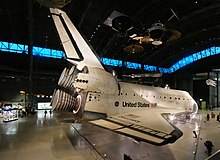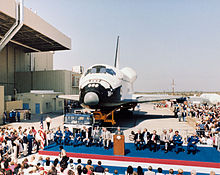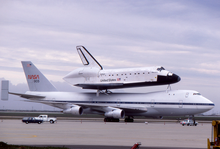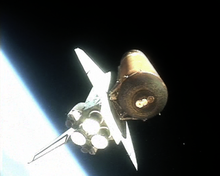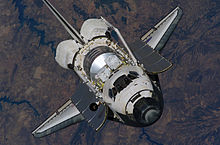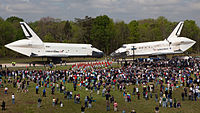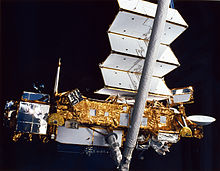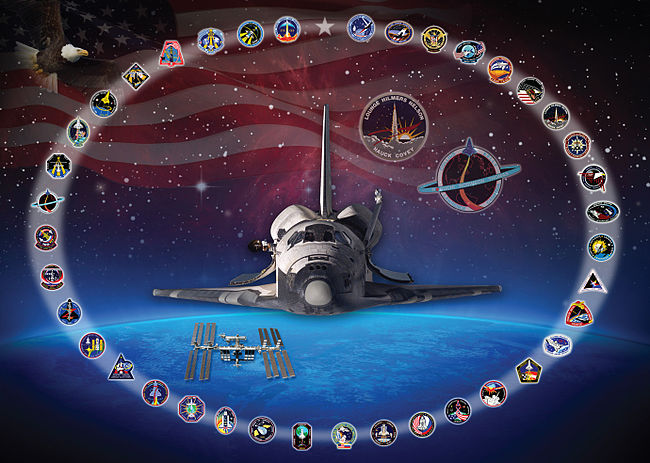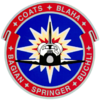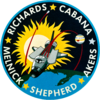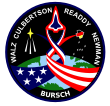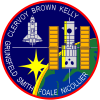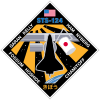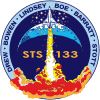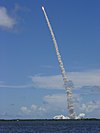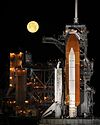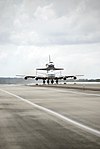| #
|
Date
|
Designation
|
Notes
|
Length of journey
|
| 1
|
August 30, 1984
|
STS-41-D
|
First Discovery mission: Judith Resnik became second American woman in Space. Three communications satellites were put into orbit, including LEASAT F2.
|
6 days, 00 hours,
56 minutes, 04 seconds
|
| 2
|
November 8, 1984
|
STS-51-A
|
Launched two and rescued two communications satellites including LEASAT F1.
|
7 days, 23 hours,
44 minutes, 56 seconds
|
| 3
|
January 24, 1985
|
STS-51-C
|
Launched DOD Magnum ELINT satellite.
|
3 days, 01 hours,
33 minutes, 23 seconds-
|
| 4
|
April 12, 1985
|
STS-51-D
|
Launched two communications satellites including LEASAT F3. Carried first incumbent United States member of Congress into space, Senator Jake Garn (R–Utah)
|
6 days, 23 hours,
55 minutes, 23 seconds
|
| 5
|
June 17, 1985
|
STS-51-G
|
Launched two communications satellites, Sultan Salman al-Saud becomes first Saudi Arabian in space.
|
7 days, 01 hours,
38 minutes, 52 seconds
|
| 6
|
August 27, 1985
|
STS-51-I
|
Launched two communications satellites including LEASAT F4. Recovered, repaired, and redeployed LEASAT F3.
|
7 days, 02 hours,
17 minutes, 42 seconds
|
| 7
|
September 29, 1988
|
STS-26
|
Return to flight after Space Shuttle Challenger disaster, launched TDRS-3.
|
4 days, 01 hours,
00 minutes, 11 seconds
|
| 8
|
March 13, 1989
|
STS-29
|
Launched TDRS-4.
|
4 days, 23 hours,
38 minutes, 52 seconds
|
| 9
|
November 22, 1989
|
STS-33
|
Launched DOD Magnum ELINT satellite.
|
5 days, 00 hours,
06 minutes, 49 seconds
|
| 10
|
April 24, 1990
|
STS-31
|
Launch of Hubble Space Telescope (HST).
|
5 days, 01 hours,
16 minutes, 06 seconds
|
| 11
|
October 6, 1990
|
STS-41
|
Launch of Ulysses.
|
4 days, 02 hours,
10 minutes, 04 seconds
|
| 12
|
April 28, 1991
|
STS-39
|
Launched DOD Air Force Program-675 (AFP-675) satellite.
|
8 days, 07 hours,
22 minutes, 23 seconds
|
| 13
|
September 12, 1991
|
STS-48
|
Upper Atmosphere Research Satellite (UARS).
|
5 days, 08 hours,
27 minutes, 38 seconds
|
| 14
|
January 22, 1992
|
STS-42
|
International Microgravity Laboratory-1 (IML-1).
|
8 days, 01 hours,
14 minutes, 44 seconds
|
| 15
|
December 2, 1992
|
STS-53
|
Department of Defense payload.
|
7 days, 07 hours,
19 minutes, 47 seconds
|
| 16
|
April 8, 1993
|
STS-56
|
Atmospheric Laboratory (ATLAS-2).
|
9 days, 06 hours,
08 minutes, 24 seconds
|
| 17
|
September 12, 1993
|
STS-51
|
Advanced Communications Technology Satellite (ACTS).
|
9 days, 20 hours,
11 minutes, 11 seconds
|
| 18
|
February 3, 1994
|
STS-60
|
First Shuttle-Mir mission; Wake Shield Facility (WSF). First Russian launched in an American spacecraft (Sergei Krikalev).
|
8 days, 07 hours,
09 minutes, 22 seconds
|
| 19
|
September 9, 1994
|
STS-64
|
LIDAR In-Space Technology Experiment (LITE).
|
10 days, 22 hours,
49 minutes, 57 seconds
|
| 20
|
February 3, 1995
|
STS-63
|
Rendezvous with Mir space station. First female shuttle pilot Eileen Collins.[14]
|
8 days, 06 hours,
29 minutes, 36 seconds
|
| 21
|
July 13, 1995
|
STS-70
|
Launched TDRS-7.
|
8 days, 22 hours,
20 minutes, 05 seconds
|
| 22
|
February 11, 1997
|
STS-82
|
Servicing Hubble Space Telescope (HST) (HSM-2).
|
9 days, 23 hours,
38 minutes, 09 seconds
|
| 23
|
August 7, 1997
|
STS-85
|
Cryogenic Infrared Spectrometers and Telescopes (CRISTA).
|
11 days, 20 hours,
28 minutes, 07 seconds
|
| 24
|
June 2, 1998
|
STS-91
|
Final Shuttle/Mir Docking Mission.
|
9 days, 19 hours,
55 minutes, 01 seconds
|
| 25
|
October 29, 1998
|
STS-95
|
SPACEHAB, second flight of John Glenn, who was 77 years of age at that time, the oldest man in space and third incumbent member of Congress to enter space. Pedro Duque became the first Spaniard in space.
|
8 days, 21 hours,
44 minutes, 56 seconds
|
| 26
|
May 27, 1999
|
STS-96
|
First Space Shuttle mission to dock with the International Space Station[14]
|
9 days, 19 hours,
13 minutes, 57 seconds
|
| 27
|
December 19, 1999
|
STS-103
|
Servicing Hubble Space Telescope (HST) (HSM-3A).
|
7 days, 23 hours,
11 minutes, 34 seconds
|
| 28
|
October 11, 2000
|
STS-92
|
International Space Station Assembly Flight (carried and assembled the Z1 truss); 100th Shuttle mission.
|
12 days, 21 hours,
43 minutes, 47 seconds
|
| 29
|
March 8, 2001
|
STS-102
|
International Space Station crew rotation flight (Expedition 1 and Expedition 2)
|
12 days, 19 hours,
51 minutes, 57 seconds
|
| 30
|
August 10, 2001
|
STS-105
|
International Space Station crew and supplies delivery (Expedition 2 and Expedition 3)
|
11 days 21 hours,
13 minutes, 52 seconds
|
| 31
|
July 26, 2005
|
STS-114
|
First "Return To Flight" mission since Space Shuttle Columbia disaster; International Space Station (ISS) supplies delivery, new safety procedures testing and evaluation, Multi-Purpose Logistics Module (MPLM) Raffaello.
|
13 days, 21 hours,
33 minutes, 00 seconds
|
| 32
|
July 4, 2006
|
STS-121
|
Second "Return To Flight" mission since the Space Shuttle Columbia disaster, owing to concerns surrounding foam debris from the external tank during STS-114; International Space Station (ISS) supplies delivery, test new safety and repair techniques.
|
12 days, 18 hours,
37 minutes, 54 seconds
|
| 33
|
December 9, 2006
|
STS-116
|
ISS crew rotation and assembly (carries and assembles the P5 truss segment); Last flight to launch on pad 39-B;
First night launch since Space Shuttle Columbia disaster.
|
12 days, 20 hours,
44 minutes, 16 seconds
|
| 34
|
October 23, 2007
|
STS-120
|
ISS crew rotation and assembly (carries and assembles the Harmony module).
|
15 days, 02 hours,
23 minutes, 55 seconds
|
| 35
|
May 31, 2008
|
STS-124
|
ISS crew rotation and assembly (carries and assembles the Kibō JEM PM module).
|
13 days, 18 hours,
13 minutes, 07 seconds
|
| 36
|
March 15, 2009
|
STS-119
|
International Space Station crew rotation and assembly of a fourth
starboard truss segment (ITS S6) and a fourth set of solar arrays and batteries. Also replaced a failed unit for a system that converts urine to drinking water.
|
12 days, 19 hours,
29 minutes, 33 seconds
|
| 37
|
August 28, 2009
|
STS-128
|
International Space Station crew rotation and ISS resupply using the Leonardo Multi-Purpose Logistics Module. Also carried the C.O.L.B.E.R.T treadmill named after Stephen Colbert
|
13 days 20 hours, 54 minutes, 40 seconds
|
| 38
|
April 5, 2010
|
STS-131
|
ISS resupply using the Leonardo Multi-Purpose Logistics Module. The mission also marked the first time that four women were in space and the first time that two Japanese astronauts were together on a space station.[31] Longest mission for this Orbiter.
|
15 days 2 hours, 47 minutes 11 seconds‡
|
| 39
|
February 24, 2011
|
STS-133
|
The mission launched at 4:53 pm EST on February 24, was carrying the Permanent Multipurpose Module (PMM) Leonardo, the ELC-4 and Robonaut 2 to the ISS.[32] Final flight of Discovery.
|
12 days 19 hours,
4 minutes, 50 seconds
|

